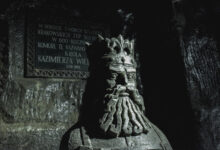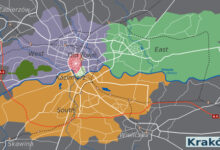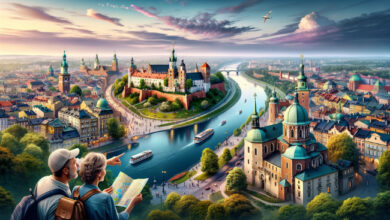Oskar Schindler’s Factory, now a museum, is located at Lipowa 4 in the district of Zabłocie, Kraków, Poland. This historical site, once the production facility for enamelware under the management of Oskar Schindler, became famous for his efforts to save over 1,200 Jews during the Holocaust by employing them in his factory.
Today, it stands not just as a monumental tribute to Schindler’s humanitarian actions but also as a reflective space for one of the darkest periods in history.
Your visit to Schindler’s Factory offers a poignant educational experience, set within the authentic surroundings where these historical events unfolded.
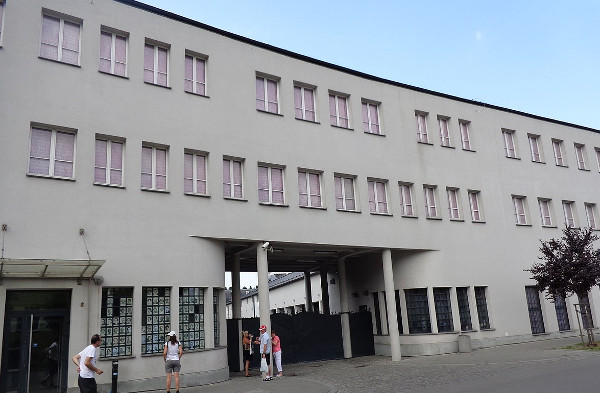
The museum, incorporated within the Historical Museum of Krakow, presents an exhibition titled ‘Kraków under Nazi Occupation 1939-1945’. This informative showcase provides an immersive insight into the life and heroics of Oskar Schindler, as well as broader aspects of Krakow’s experience during World War II.
Reaching the museum is straightforward, with tram lines 6, 13, 23, 3, 9, 19, 24, 50, 11, and 20 serving nearby stops such as Limanowskiego, Bohaterów Getta and Zabłocie.
Table of Contents:
Schindler Factory Historical Background
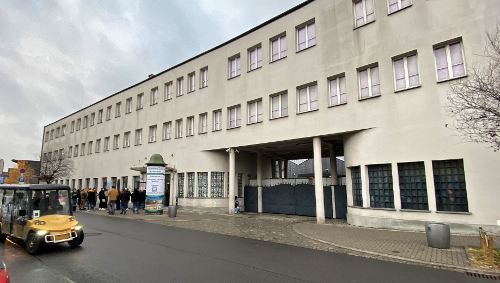
In the heart of Krakow’s Zabłocie district lies the enamelware factory, famously associated with Oskar Schindler, a German entrepreneur who saved the lives of many Jews during World War II.
This section uncovers the origins of the factory, Schindler’s involvement during the war, and its metamorphosis into a museum.
Origins of the Enamelware Factory
The factory began as a place for producing enamelware, a type of kitchenware finished with a glossy, protective coating. Prior to World War II, this factory was just one of many industrial sites in the region. However, the Nazi occupation transformed its role significantly.
Oskar Schindler and World War II
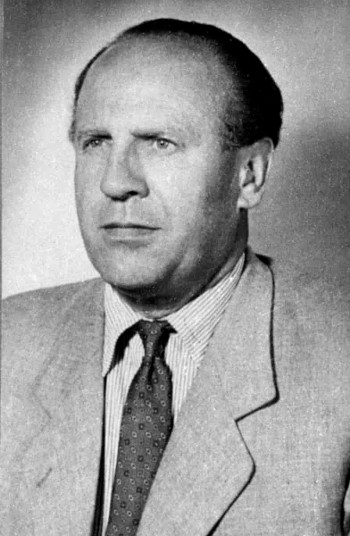
During the war, the entrepreneurial Oskar Schindler took over the enamelware factory, renaming it Deutsche Emailwarenfabrik. Schindler, a member of the Nazi Party, used his status and connections to protect his Jewish workforce from the horrors of the Holocaust.
The real events later inspired the film Schindler’s List, which brought widespread attention to his actions.
The Transformation into a Museum
After the war, Schindler’s factory went through several changes before finally becoming a museum dedicated to the memories of those saved by Schindler and the history of Nazi occupation in Krakow.
The museum portrays a poignant part of history, allowing you to walk through exhibits that detail life during World War II and the extraordinary story of the enamelware factory and its workers.

Schindler’s Factory Today
Once a wartime production site, Schindler’s Factory in Kraków now stands as a significant symbol and educational site, capturing a poignant era in history.
Museum of Contemporary Art
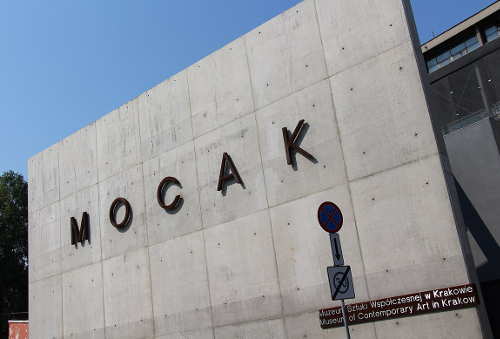
Adjacent to Schindler’s Factory, the Museum of Contemporary Art in Kraków (MOCAK) showcases a rich variety of modern artworks. You’ll find a collection that includes both Polish and international contemporary art. Exploring MOCAK offers a contrasting experience that resonates with the themes of resilience found at Schindler’s Factory.
Exhibiting History and Remembrance
Schindler’s Factory itself has been repurposed into a museum dedicated to preserving the memory of the Holocaust and the stories of the Jewish workers who were saved from Auschwitz.
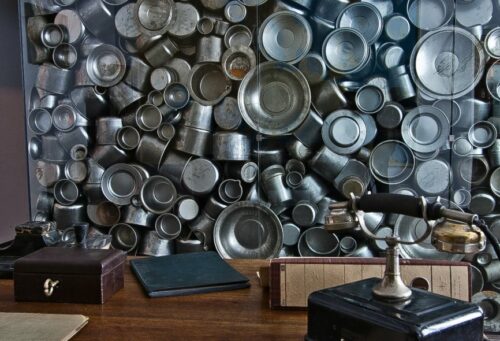
The exhibitions provide a profound narrative of their struggle and Oskar Schindler’s endeavours. Engaging displays and authentic artefacts immerse you in the historical context of the era.
Visitor Information
If you’re planning a visit to Shindler Factory Museum:
- Address: Lipowa 4, 30-702 Kraków, Poland
- Trams: To reach Schindler’s Factory, take lines 6, 13, 23 to Limanowskiego, lines 3, 9, 19, 24, and 50 to Bohaterow Getta, or lines 11 and 20 to Zablocie.
- Tickets: Entry require a ticket purchase, and it is wise to check current prices and availability, as they can change. Read more Schindler Factory Tickets
- Guided Tour: Opting for a guided tour will provide a more in-depth understanding of the site’s history and the epoch it represents. Read more Schindler Factory Tour Price
- Exhibitions: The enduring exhibitions at Schindler’s Factory offer informative insights into the lives of those affected by the events surrounding the Holocaust.
- Opening Hours: The Schindler Factory is open from 10:00 to 14:00 on Mondays and from 9:00 to 18:00 from Tuesday to Sunday. However, it is important to note that the facility is closed on the first Tuesday of every month. Read more Schindler Factory Opening Hours
Location and Accessibility
Schindler’s Factory, a significant historical site nestled in Kraków, is readily accessible by various modes of transportation. Whether you prefer public transit or private services, reaching this landmark is straightforward.
Getting to Schindler’s Factory
To visit Schindler’s Factory, located at Lipowa 4, 30-702 Kraków, you have several transportation options:
By Tram: Kraków’s tram system is efficient and well-connected. Key tram stops for Schindler’s Factory include:
- Limanowskiego, with lines 6, 13, and 23.
- Plac Bohaterów Getta, with lines 3, 9, 19, 24, and 50.
- Zabłocie, accessible via lines 11 and 20.
Check the tram schedules to ensure timely arrival.
By Uber: For convenience, you may opt for an Uber ride. Simply enter the address and enjoy a direct journey to Schindler’s Factory.
Zabłocie District and Its Significance
Zabłocie is a district steeped in history and transformation:
- Historical Context: Once an industrial hub, it was the location of Oskar Schindler’s enamel factory during World War II. This area played a crucial role in saving numerous lives.
- Modern-Day Appeal: Today, Zabłocie is a mix of artistic and cultural centres, located just across the Vistula River from the historic quarter of Kazimierz. Its significance has multiplied as it’s evolved into a vibrant neighbourhood that reflects Kraków’s past and present.
The Impact of Schindler’s Actions
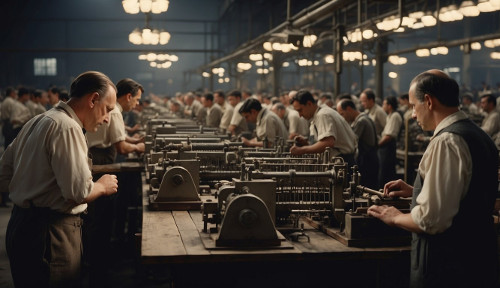
Oskar Schindler’s actions during World War II serve as a testament to bravery and humanity in the face of grave atrocities. His strategic use of his factory not only disrupted the trajectory of Jewish suffering but also left a legacy that transcends generations.
Saving the Jewish Population
Oskar Schindler, operating his enamelware factory in Kraków and later an ammunition factory, employed Jews who otherwise faced certain death in concentration camps. By including them on his “list,” he shielded over 1,200 people from the Nazi regime’s efforts to deport them to extermination camps.
Schindler’s factories, especially the one famously known as ‘Emalia’ in Kraków, became sanctuaries contrasting greatly with the perilous conditions in the Jewish Ghetto.
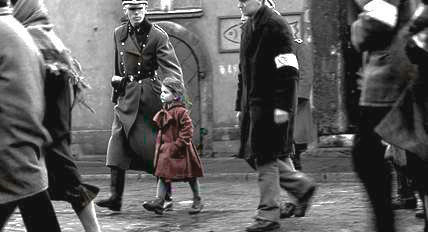
Leveraging his membership in the Nazi Party and the wartime economy, Schindler could bribe Nazi officials to keep his workers protected. The Jews employed by Schindler were deemed essential to the war effort, which bureaucratically and physically distanced them from the threat of annihilation.
Legacy and Recognitions
Schindler’s extraordinary endeavours garnered international recognition. Most notably, he was honoured as Righteous Among the Nations, a title bestowed by the state of Israel to non-Jews who risked their lives to save Jews during the Holocaust.
The ripple effect of his deeds has been felt across various domains, from literature to film.
- Thomas Keneally showcased Schindler’s story in his novel “Schindler’s Ark,” which intricately details the events surrounding Schindler’s factory and his audacious rescue missions.
- Then, Steven Spielberg brought the narrative to the silver screen in the critically acclaimed film Schindler’s List, offering millions of viewers a poignant look into these historical acts of defiant compassion.

These adaptations have ensured that Schindler’s ingenuity in combating one of history’s darkest periods remains embedded in public consciousness. They serve to educate and remind you of the profound impact one individual can have, even amidst widespread horror.
Engaging with the Experience
The Oskar Schindler’s Factory offers a profound journey into a significant historical epoch. Here you have the opportunity to enhance your understanding through educational insight and interactive engagement.
Education and Guided Tours
Your visit can be greatly enriched by participating in educational programmes and guided tours. These tours provide critical context and deeper insights into the historical relevance of the factory.
You are accompanied by knowledgeable guides who narrate powerful stories and facts behind the numerous exhibits. Educational sessions are structured to cater to varying age groups, ensuring a comprehensive learning experience.
For Tourists:
- Guided Tours: Engage directly with history alongside professional guides.
- Educational Programmes: Tailored sessions to expand historical understanding.
Artifacts and Interactive Displays
At the heart of the museum are the artifacts and interactive displays which offer an immersive experience. You encounter original objects, each with its own story.
Authentic photographs from the era help visualise the past vividly, while interactive exhibitions allow you to explore facets of wartime Kraków.
Surrounding Area Attractions
Exploring the area around Schindler’s Factory offers you a poignant look into the historical context of Kraków during WWII, as well as access to a variety of significant sites steeped in history.
Podgórze and Kraków Ghetto
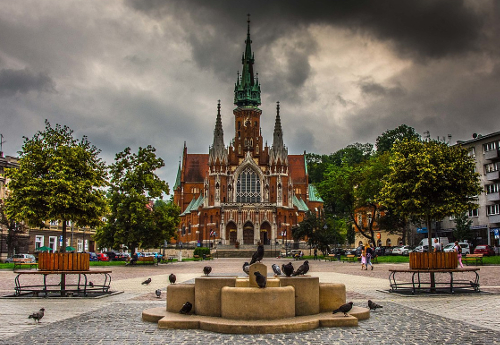
Podgórze, once a separate town, played a pivotal role during the Second World War. It’s the location of the former Kraków Ghetto where Jews were forced to live before facing deportation to concentration camps.
When you visit, you can still see remnants of the ghetto walls and the touching memorial at Plac Bohaterów Getta (Ghetto Heroes Square). Nearby, the Pharmacy Under the Eagle (Apteka pod Orłem), which is now a museum, served as a beacon of hope to the Kraków Jews trapped in the Ghetto during the war.
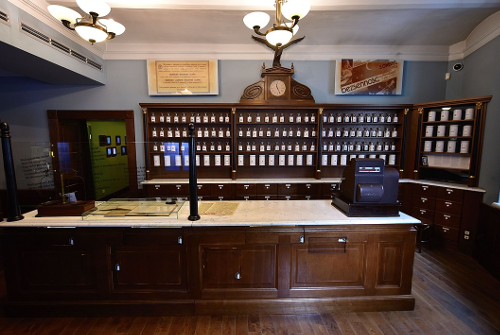
Nearby Historic Sites
Your visit to Schindler’s Factory can be extended to encompass other key historic sites.

Among these, Wieliczka Salt Mine stands out, a UNESCO World Heritage site which is not only historically important but features breathtaking underground chapels carved out of salt.
Additionally, the Płaszów Concentration Camp, known from Schindler’s story, remains a sombre reminder of history, now marked with memorials to those who suffered there.
In contrast, stepping back into the heart of the city, Kraków’s Old Town and its Main Square offer a lighter ambience with well-preserved medieval architecture and numerous tourist attractions.


